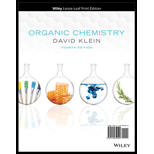
(a)
Interpretation:
The transformation from the given starting material to the target molecule must be shown along with Retrosynthetic analysis.
Concept Introduction :
A Retrosynthetic analysis helps to find out the suitable starting material for a target molecule synthesis. Thioether can be synthesized following
(b)
Interpretation:
The transformation of the target molecule must be shown along with Retrosynthetic analysis.
Concept Introduction :
A Retrosynthetic analysis helps to find out the suitable starting material for the synthesis of a target molecule. Williamson ether synthesis follows the SN2 pathway in which sodium alkoxide and alkyl halide are used.
Want to see the full answer?
Check out a sample textbook solution
Chapter 7 Solutions
ORGANIC CHEMISTRY-PRINT (LL)-W/WILEY
- Select the conditions in which elimination/condensation is most likely to occur. Note that only one of these needs to be present for elimination/condensation to be likely. Protic solvent Aprotic solvent Acidic conditions Basic conditions Cold Hot Shorter reaction time Longer reaction timearrow_forwardShow the complete mechanism for the following transformation.arrow_forwardComplete the mechanism for the formation of the major species at equilibrium for the reaction of butanal in methanol solvent and catalytic aqueous acid. Make sure to include any missing atoms, bonds, charges, nonbonding electrons, and curved arrows.arrow_forward
- Give two possible [1,2]-rearrangement products where an alkyl group migrates in the following compound. Motivate also which of the two products will be formed preferentiallyarrow_forwardSeveral reagents and several organic structures are shown below. Construct a multistep synthetic route for the synthesis of acetylene from ethane by dragging the appropriate pieces into the bins. Note that each bin will hold only one item, and not every given reagent or structure will be used. (Stoichiometry is omitted.)arrow_forwardSynthesise the target molecules drawn below using precursor chemicals within the following limitations: 1) ALL intermediates and reagents must be shown.2) Each molecule requires multiple step synthesis.3) You must also synthesize any organometallic reagents or ligands that you wish to use. b) Use any precursor molecules with 7 carbon atoms or less.arrow_forward
- Nonearrow_forwardSeveral reagents and several organic structures are shown below. Construct a multistep synthetic route from the reactant 2-methyl-1-butene to the product 3-bromo-2-methyl-2-butanol by dragging the appropriate pieces into the bins. Note that each bin will hold only one item, and not every given reagent or structure will be used.arrow_forwardSynthesise the target molecules drawn below using precursor chemicals within the following limitations: 1) ALL intermediates and reagents must be shown.2) Each molecule requires multiple step synthesis.3) You must also synthesize any organometallic reagents or ligands that you wish to use. a) Aspirin is a common pain killer that was developed by Bayer.arrow_forward
- In a Wittig reaction, a ketone or aldehyde reacts as an electrophile with a nucleophile called a Wittig reagent (or phosphonium ylide) to produce an alkene. The Wittig reagent is commonly synthesized first in a two-step process beginning with an alkyl halide, then reacted with the carbonyl compound. In this problem, you'll explore the mechanism of a multi-step synthesis to make an alkene using the Wittig approach.arrow_forwardwhat is a multistep synthesis for this transformation. add any reagents or compounds to help accomplish itarrow_forwardProvide a multi-step synthesis of the "Final Product" from the given "Reactant" by completing the synthesis scheme below. Draw the entire synthesis scheme & complete the synthesis scheme and box your answers as shown below. Indicate the set of reagents/conditions #1, #2, and Draw the chemical structure of major organic product at each step i.e. Compounds A, B, and C. Each set of reagents/conditions may contain more than one reagent. Use the notation 1., 2., etc., to show the steps in each set of reagents/conditions as appropriate. Do not show any curved-arrow pushing mechanisms. (Reactant) Final Product TSOH HO OH Compound A Reagents/Condition(s) #1 Compound B MOTHE Reagent(s)/Condition(s) #2 Compound Carrow_forward
 Organic Chemistry: A Guided InquiryChemistryISBN:9780618974122Author:Andrei StraumanisPublisher:Cengage Learning
Organic Chemistry: A Guided InquiryChemistryISBN:9780618974122Author:Andrei StraumanisPublisher:Cengage Learning
